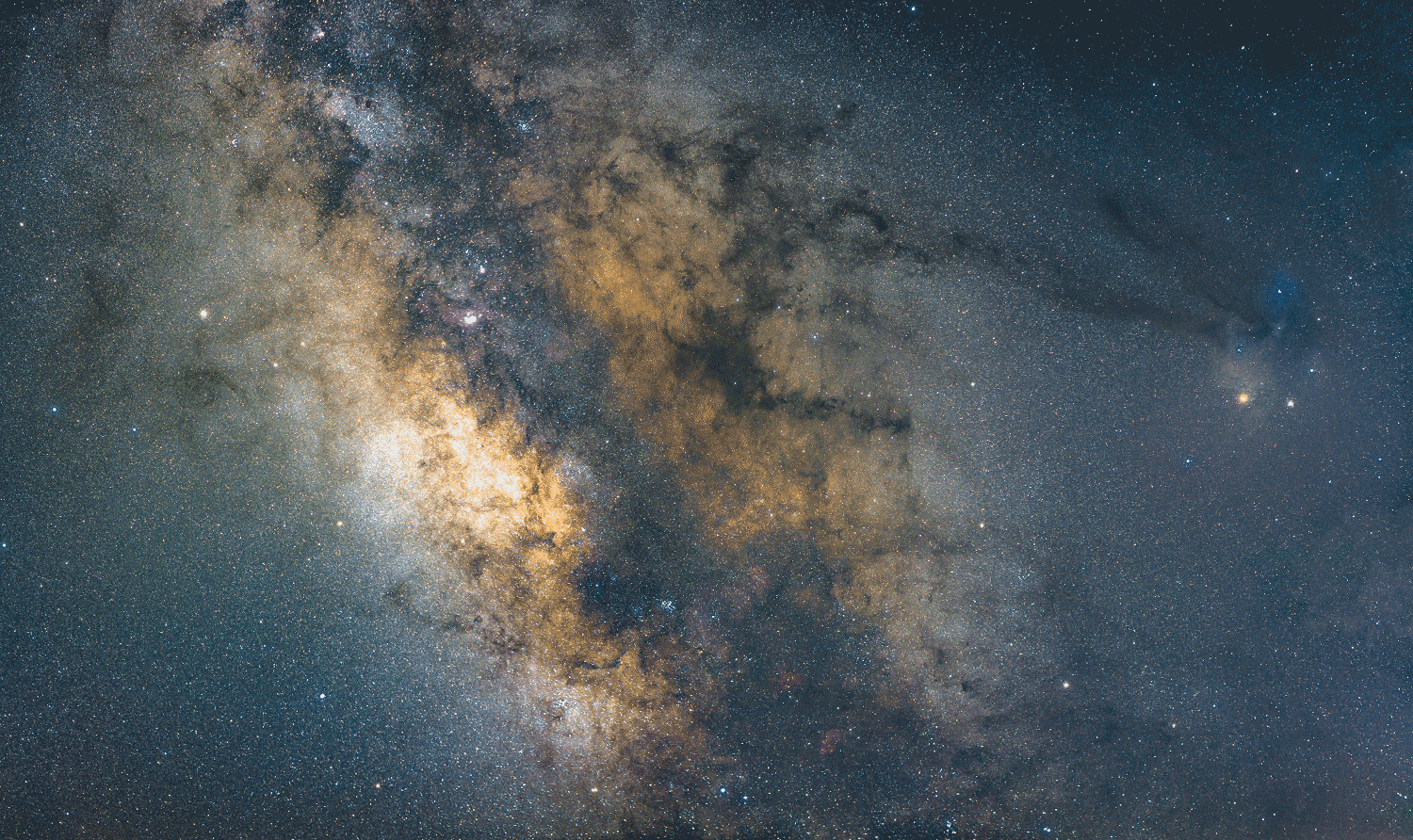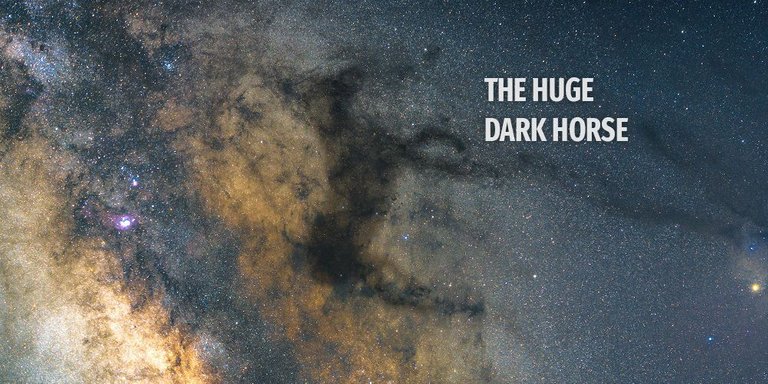Hey guys, welcome back for another journey! Today is not a great day for me: so much to do. I have too many deadlines approaching and, if that's not enough, last night I left my phone in the car of a girl I will see in a few days. But I should not care... it's Friday! But ... why am I talking about this? Let's talk about serious things... let's talk about the center of the Milky Way, our home.
Our Milky Way is huge: 100,000 light years! Yes. Light needs 100,000 years to travel along the diameter (Milky Way looks like a disk from above). It is made up of billions of stars. Inside of it there is everything you can imagine: emission nebulae, reflection nebulae, dark nebulae, stars, millions of other probably uninhabited (?) planets and much more. All these objects (including our beloved solar system) rotate together around the so-called galactic center [click to enlarge].
This portion of the sky, the richest ever, is right in the galactic center of our Milky Way. The picture you see is a combination of 4 shots captured with a simple 50mm lens and therefore includes a very big portion of the sky.
On the right you can see a big yellow/orange star. That is Antares in Scorpio. This star resides in the Antares Region (astronomers are not known for the great fantasy) near the Rho Ophiuchi Region (I talked about this beautiful part of the Milky Way in my first article ).
Thanks to the very large FOV (field of view) of the lens I managed to get more than one constellation into one picture:

Some constellations
And there are dozens of objects usually observed (and photographed) by amateur astronomers:

A lot of deep sky objects of the following catalogues: Messier, Barnard, New General Catalogue
Brightest areas of the photo are the richest of stars. It's like looking at our city center from the road that takes us to the suburbs. Darker areas are dark nebulae instead and are like smog or clouds in our city. These clouds of intergalactic material are so dense that light can't pass through and reach us. These clouds one day will collapse on themselves giving rise to new stars. Red and purple areas are emission nebulae emitting in the red spectrum (H-alpha line 656,3 nm).
This dark nebula below is one of the largest dark nebulae, the Huge Dark Horse Nebula. Can you find it? I gave you a small hint...

The Huge Dark Horse
And this one is one of my favorites dark nebulae, the Snake Nebula:

The Snake Nebula (B72)
There are many other things to say. If you want, we can talk about it in the next articles. So for today the trip ends here... I have too many things to do and a phone to recover (damn!). See you soon. Clear skies guys!
And remember: if you need help with astro/photography or if you want to talk about equipment/processing just comment below ;) Bye!

For the most curious, I've used a Canon EOS 60D (unmodded) and a Canon 50mm 1.8 STM on an HEQ5 unguided mount. Photos acquired with EOS Utility. Calibration and stacking made with Deep Sky Stacker and post-processing with Photoshop.
50mm - f/3.2 - ISO800
Light Frames: 4x10x 120''
Dark Frames: 15x 120''
Alessio Vaccaro
Follow @ilvacca and upvote if you want more contents like this one. Thank you


Congrats you have been selected as Author of the day by the Steemvoter (SV) Guild, keep up the good work and helping make Steem great!
Note: You should receive many guild votes in an hour or so, enjoy!
What a good news! Thank you
wow that looks amazing follow me and i will follow you back
Beautiful picture, but is it real capture from any camera?
It is a real capture, yes. You can do this with any camera over 300-400€. Obviously you need a more expensive camera if you want to get high quality images :)
What lenses did you use?
I used a Canon EF 50mm f/1.8 STM (about 120€)
What brand and type of your camera?
You can find this details in the Technical Details section. My camera is a Canon EOS 60D. It is a mid level reflex.
Congratulations @ilvacca! You have completed some achievement on Steemit and have been rewarded with new badge(s) :
Click on any badge to view your own Board of Honnor on SteemitBoard.
For more information about SteemitBoard, click here
If you no longer want to receive notifications, reply to this comment with the word
STOPIf you want to support the SteemitBoard project, your upvote for this notification is welcome!
nice...
Would love to get into this thanks for the inspiration.
Amazing pictures!!! And great clarity!! @ilvacca
Thanks for sharing :)
Congratulations @ilvacca! You have completed some achievement on Steemit and have been rewarded with new badge(s) :
Click on any badge to view your own Board of Honnor on SteemitBoard.
For more information about SteemitBoard, click here
If you no longer want to receive notifications, reply to this comment with the word
STOPIf you want to support the SteemitBoard project, your upvote for this notification is welcome!
Dude, im so jealous! Maybe one day i'll get me a telescope camera set up with leftover steem ;)
Congratulations @ilvacca! You have completed some achievement on Steemit and have been rewarded with new badge(s) :
Click on any badge to view your own Board of Honnor on SteemitBoard.
For more information about SteemitBoard, click here
If you no longer want to receive notifications, reply to this comment with the word
STOPIf you want to support the SteemitBoard project, your upvote for this notification is welcome!
Amazing work..love it
Beautiful photos! Very Interesting. I followed you. Will you follow me.
Thank you. Sure, I love extreme travels and sports too ;)
First time seeing Huge Dark Horse Nebula. It's so interesting and your photo is really well done. Love the details ;)
Thank you kaz1k!
Thanks for the amazing pictures and the detailed information! I didn't know about this Dark Horse Nebula. Wow!
The sky is full of surprises ;)
Outstanding beautiful. Thank you so much being here on Steemit :)
Thank you dimitry
meep
nice shots! keep them coming.
Thank you! Sure ;)
Absolutely spectacular photos and with all necessary data + help offer to those interested in astrophotography! You are the man of the day – Upvoted, resteemed, followed & Daily Photo Selection
Thank you for the feature, the resteem, the upvote and the follow!!! I really appreciate it! ;)
Love it! I've got my own cheap telescope and I want to get into astrophotography, could you give me a great budget startupkit and would you know anything about building a barn door tracking mount?- is it worth the savings? Looking forward to seeing more!
Very nice! First of all you need to decide what you really want to photograph. Let's suppose you want to photograph the milky way (like the photo above).
You can do this with a simple camera and an astrotracker (like the barn door tracking mount you're talking about). This type of astrophotography is quite simple in contrary to deep sky astrophotography because you use very short focal length and then you don't really need very accurate mounts. For example some astrotracker are: the Sky-Watcher Star Adventurer, the Sky-Watcher Star Adventurer Mini or the iOptron SkyGuider Pro. They cost about 350-550€ and can return very nice results! If you buy one of these, a mid-level camera (like a Canon 700D), a nice fixed lens like a Samyang or Rokinon 85 f1.4 and you can take incredible pictures, trust me! Yes, the total price its high (let's say 400+450+300€=1150€) and you have to learn how to post process and the basics but this is everything you need to take beautiful wide field astrophotos. I never tried a diy barn door tracking mount so I can't talk about it. If its cost is not so high you can try to build it one. With low focal lengths it probably works good! To summarize: the sky moves so, substantially, the longer the focal length the higher the accuracy you need. And with a fast lens (f2, f1.4, f2.8) you win.
If you want to go further (focal length > 300mm) you need more accurate equipment. You need a more solid and motorized mount like an HEQ5 (mine) or EQ5, EQ6. These are mid-entry level mounts very nice for astrophotography because they are relatively cheap (800€-1200€ I know, astrophotography is not cheap!) and can support up to 10-15 kg. Obviously you can use it for wide field (I shot the photo above in this way) but they are thinked to carry telescopes. For example you can think to buy an HEQ5 now and use it with your camera (if you have one). When your skills has grown you can think about buying a telescope. With longer focal length you can take galaxies (they are veeery small so you need very long focal length (1500mm)) and mid-nebulae (the entire Snake Nebula for example). In this case the use of a CCD or CMOS dedicated camera is highly recommended (>1500€).
I hope I was clear. Sorry for some English mistake but I wrote it all in a hurry! And sorry for the Euro-Dollars conversion! :D
Thank you so much for your advice and recommendations! You've explained so much valuable tips and thanks for including the different options for gear, it really does help and even have something to eventually aim for while I build upon the skills! :) I'm only in the UK so i know Euros estimate quite well! :) Looking forward to seeing more of your work! :D thanks again!
Beautiful work!
Thank you!
+1 upvote.
Wow, these photos are stunning! I have attempted astro photography a couple times, but I grew a little impatient and didn't capture anything worth while. I need to try again! Thanks for giving the technical details. Wonderful post. Upvoted & following :)
Thank you! I have to admit it: astrophotography is not very simple. C'mon it's time to start again ;)
Incredible! What a gorgeous set of photos. Thank you for including the indications as well. It's hard for me to see things in the sky but now that you have shown them, I do see clearly. Wonderful, wonderful post!
So beautiful is the majesty of our galaxy.
Beautiful and informative!
Very interesting post, stunning photos!
Thanks for sharing your photos. The "Huge Dark Horse" is actually amazing. In the ways of astronomy you need a lot of imagination to see these shapes, but the "Dark Horse" really looks like a horse :)
Are these Northern or Southern Hemisphere views?
Wow amazing picture friend!! An objective judgment according to what I have understood, it arises from it because it has an artistic or exquisite value. always do your best.
Cool photos
Amazing photos! Thanks for sharing.
Beautiful! Astrophotography is so magical, it reminds me of some sort of magical/mystical fairy dust :)
This is beautiful. Looking forward to more.
Great work, i've always been fascinated by the milky way. Im hoping to get out this summer and capture some along the california coast.
Thank you for this magnificent post. Very to the site, today is just the day of the Space :)
Good article, great pictures, very professional looking. I am looking forward to hearing more from you.
Great shots! Congrats!
Complimenti per le foto sono incredibili! Veramente meravigliose e sorprendenti! Buona serata,
Nicola